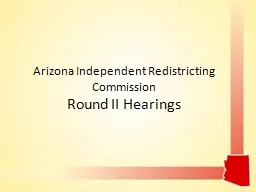

Round II Hearings Overview Arizonas redistricting process is governed by the state Constitution as amended by voters in 2000 with the passage of Proposition 106 It stipulates that the Arizona Independent Redistricting Commission redraw Arizonas congressional and legislative districts t ID: 389829
Download Presentation The PPT/PDF document "Arizona Independent Redistricting Commis..." is the property of its rightful owner. Permission is granted to download and print the materials on this web site for personal, non-commercial use only, and to display it on your personal computer provided you do not modify the materials and that you retain all copyright notices contained in the materials. By downloading content from our website, you accept the terms of this agreement.
Slide1
Arizona Independent Redistricting Commission
Round II HearingsSlide2
Overview
Arizona’s redistricting process is governed by the state Constitution, as amended by voters in 2000 with the passage of Proposition 106. It stipulates that the Arizona Independent Redistricting Commission redraw Arizona’s congressional and legislative districts to reflect the results of the most recent census. Due to the 2010 Census, Arizona gained a congressional seat.
2Slide3
What are the requirements of the State Constitution via Prop 106?
New district boundaries must:
A: Comply with the U.S Constitution and the Voting Rights ActB: Equal PopulationCriteria A and B are federally mandated. To the extent practicable the districts must be:C: Compact and ContiguousD: Respect communities of interest
E: Use visible geographic features, city, town and county boundaries, and undivided Census Tracts
F: Favor competitive districts where no significant detriment to other goals
3Slide4
A: Voting Rights Act
Arizona’s congressional and legislative districts must receive preclearance or approval from the Department of Justice or a federal court under Section 5 of the Voting Rights Act before they can take effect. To get preclearance, Arizona must demonstrate that the new districts do not discriminate against minority voters in purpose or effect, which means there can be no intentional or accidental discrimination.
Under Section 5, Arizona's redistricting plans cannot be retrogressive. The plans cannot weaken or reduce minority voters' rights. The presence of discrimination can be determined by analyzing population data and election results.
4Slide5
Bruce L. Adelson, Esq.
Federal Compliance Consulting LLC
5Slide6
Timeline
Step 1:
Setting up the Commission – Commissioners are appointed following a thorough screening process. Step 2:
First-Round Hearings
Before drawing a single line, the Commission held 23 public hearings around the state in July and August to get input from members of the public about issues relevant to redistricting such as geography, communities of interest, minority voting rights, and competitiveness.
6
Scott Freeman, Vice Chair
Jose
Herrera,
Vice
Chair
Colleen Mathis,
Chair
Linda McNulty
Richard
Stertz
Republican
Democrat
Independent
Democrat
Republican
Maricopa
County
Maricopa
County
Pima County
Pima County
Pima CountySlide7
Timeline
Step 3:
Mapping – Start with a clean slateThen divide the state into equal population and compact grid like districts -- Grid Map Approved August 18Since adopting the grid maps, the Commission has met more than 25 times to consider adjustments to the grid to accommodate all of the state constitutional criteria. During this time they received additional public comment and draft maps. Approval of Draft Maps – On October 3, the Commission approved draft congressional map that incorporated changes based on all of the constitutional criteria. It approved draft legislative map on October 10.
7Slide8
Timeline
Step 4:
Second Round Hearings – Currently visiting 30 towns and cities to share the draft maps and receive additional public input during the month of October and NovemberStep 5: Final MapsUpon completion of a public comment period, the AIRC will adopt final maps
Step 6:
Preclearance Because Arizona is subject to Section 5 of the Voting Rights Act, the district maps must be approved by the federal Department of Justice or the federal court in Washington, D.C. before they can be used for Arizona elections
8Slide9
Congressional Map used in 2010
9Slide10
Starting Point -- Congressional Map
10Slide11
Congressional Grid Map
11Slide12
Congressional Draft Map
12
The draft congressional districts include:
Two predominantly rural districts
Three border districts
Three districts in the greater Tucson region
Five districts that are entirely in Maricopa County
It avoids splitting Arizona's Indian Reservations
Two districts where minority voters have the opportunity to elect their candidate of choiceSlide13
Legislative Map used in 2010
13Slide14
Starting Point -- Legislative Map
14Slide15
Legislative Grid Map
15Slide16
Legislative Draft Map
16
The draft legislative districts include:
Population growth and reduction:
Old districts -- about 155,000
to 378,000
Current draft -- about 207,000 to 215,000
To comply with the Voting Rights Act, the draft plan includes ten districts in which minority voters should have the opportunity to elect their candidate of choice.
The draft includes
Three districts wholly within Pima County (districts 3, 9 and 10) and three additional southern Arizona districts (1, 2 and 4)
17 districts primarily within Maricopa County (12, 15-30)
9 districts primarily rural (1, 4, 5, 6, 7, 8, 11, 13, 14)Slide17
17
Fill out a request to speak form at a
public hearing and provide the commission you input. Example of input includes thoughts on:
All Constitutional Criteria
Draft Congressional Map
Draft legislative Map
You can submit your input by:
Speaking at a hearing
Filling out a public input forms at the hearing or on the AIRC website
Visit us at
www.azredistricting.org
or call 602-542-5221 or toll free at 855 – 733-7478
The AIRC Wants Your InputSlide18
18
Maps
The AIRC Wants You to Stay Connected
Maps
Meetings
Public Input Slide19
19
Finding Draft MapsSlide20
Viewing the KMZ (Google) Map
20Slide21
21
Zoom in on your districtSlide22
22
Visit our website
at:
www.azredistricting.org
to
Draw your own maps
Watch current meetings or past meetings
Get updates on future meetings
Follow us on Twitter #AIRC
Friend us on
Facebook
http://www.facebook.com/#!/azredistricting
The AIRC Wants You to Stay Connected